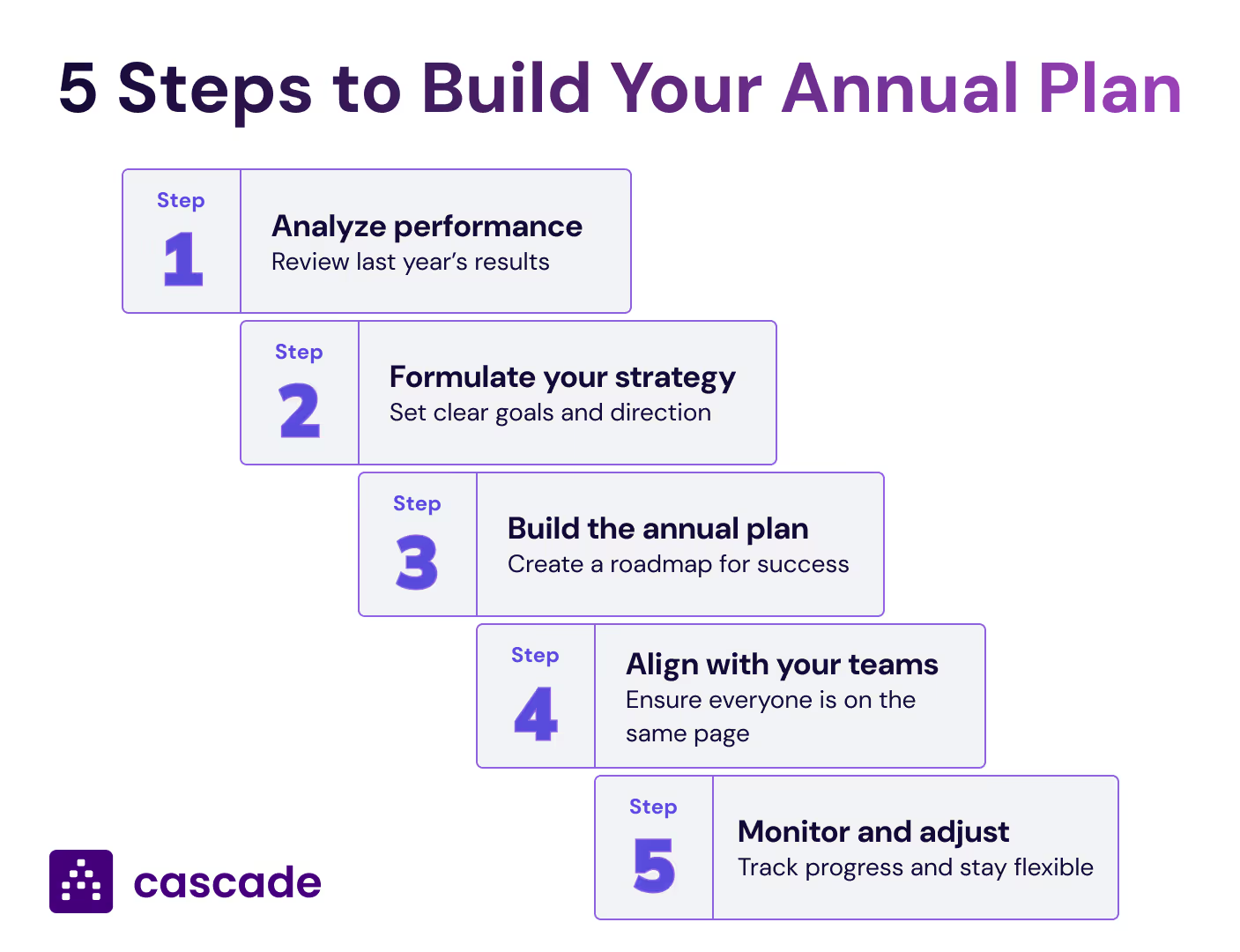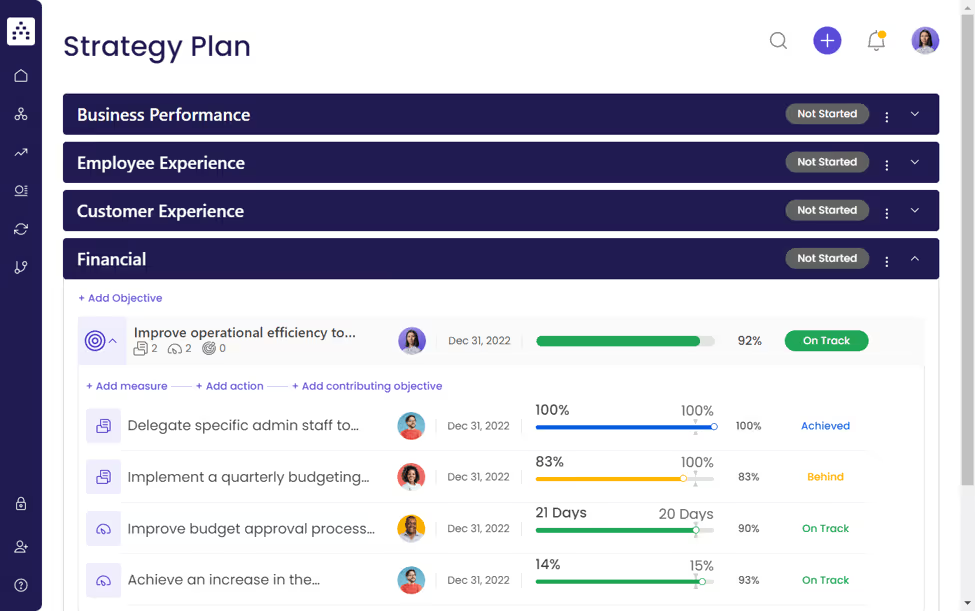Get ready to take your strategic annual planning game to the next level! This process is essential for companies who want to set a clear direction for the future and ensure everyone is working towards the same goal.
But, let's be real, executing a killer strategic plan is easier said than done. That's why we're here to help you help you build a bullet-proof annual plan for the upcoming year.
In this article, we'll dive into the nitty-gritty of annual planning and cover all the tips and tricks you need to know. From involving the right people to communicating your plan like a pro, we've got you covered.
We'll also share some common pitfalls to watch during the annual planning process and provide real-life examples to help bring it all to life.
So, whether you're a seasoned planning pro or just starting out, get ready to learn how to make your annual strategic planning a total success!
In this article, you’ll discover:
- What Is Annual Planning?
- The Benefits of The Annual Planning Process
- 5 Steps To Build A Highly Effective Annual Plan
- The Only Annual Planning Template You Need in 2024
- 7 Mistakes to Avoid When Conducting Annual Strategic Planning
- Build And Execute Your Annual Plan With Cascade 🚀
🎥 Prefer to watch? Check out our YouTube podcast on "Planning for the New Year" for insights on reflection, goal setting, budgeting, and monitoring strategies.
What Is Annual Planning?
.avif)
Annual planning is about turning long-term business goals into short-term action plans for the year ahead. It contains insights from past performance and a clear roadmap with a timeline. This yearly plan should be realistic and achievable, while also being ambitious enough to move the business forward.
Annual planning is your opportunity to take the previous year's wins, knocks, and lessons and adjust your strategy to help your business grow consistently and become better.
Miriam Lesa, Strategy Execution Director at Cascade, emphasizes: "It’s not about starting from scratch. Reflect on the wins and lessons from the previous year. Because as you're approaching the new year, you already have a good indication of what's worked and what hasn't. That reflection is crucial to set you up for success."
Annual planning and regular reviews help you proactively adjust strategies, adapt to changes, and steer your organization in the right direction to get the business results you want by the end of the year or toward your vision in the future.
The Benefits Of The Annual Planning Process
Whether it's your IT, supply chain, pricing, marketing, operations, or sales strategy—improving, pivoting, or optimizing your annual planning approach from one year to the next year is non-negotiable. The annual planning process will help you assess the effectiveness of your business strategies and make adjustments to keep up with customer needs and market trends.
An effective annual planning process for the new year can offer the following benefits.
.avif)
Provide strategic clarity
Annual strategic planning helps define and align goals, mission, and values, leading to more focused and effective decision-making across all levels of the organization. This in turn sets a clear and consistent direction for future initiatives, maximizing the organization's potential to achieve success.
Maintain long-term focus
By regularly reviewing and updating its strategic plan, your organization stays focused on long-term objectives instead of being constantly sidetracked by day-to-day operations.
Laura Blackmore, Head of Strategy Execution at Cascade, advises, “You need to reflect on the last year's performance and celebrate your wins. Taking stock of what worked will help you build on your strengths going into the new year.”
Benchmark performance
An annual strategic planning process helps you measure and track progress on key strategic initiatives, and evaluate the progress made compared to last year.
Identify gaps and opportunities
By regularly reviewing your strategic plan, your teams will identify gaps and opportunities for improvement and innovation, which can help you stay ahead of your competition.
Optimize resource allocation
By aligning your strategic plan with your budget, you can allocate resources that will support your goals and cut costs from misaligned initiatives.
Increase engagement and buy-in
Involving key stakeholders in the strategic planning process will increase engagement and buy-in across your organization, leading to a more cohesive and motivated team.
A clear and execution-ready annual plan that focuses on the big picture and pays attention to the details can be the glue that binds your teams together. And this is crucial if you want to reach this year's goals with greater speed and efficiency. Plus, it's much better than the alternative of just winging it and hoping for the best!
📚 Recommended read: How To Create An Effective Annual Operating Plan (+Template)
5 Steps To Build A Highly Effective Annual Plan
Don't get us wrong—creating and managing a yearly planning process can be a daunting task. But, with the right approach, you'll be able to get it right and start executing faster. Here's how to do annual planning the right way:

1. Analyze your performance and identify opportunities
Before you set goals, you should do an analysis of your company's current performance, market, and competitors to see where you stand.
Miriam advises, “Do a proper post-mortem. Look not only at what worked in terms of your business, but also in terms of processes, customers, and employees. This holistic check-in will give you a great starting point for your annual plans.”
Here are some tools you can use in the process:
- SWOT analysis
- PESTLE analysis
- Porter’s Five Forces
- Competitive analysis
- Financial performance of the previous year
- Gap analysis
A better understanding of your current performance can help you make data-driven decisions when building your annual plans for the year ahead.
Want to make it fail-proof? Don't forget to include key stakeholders who will be involved in the day-to-day execution of your annual plan.
Here's who should be included in the analysis process:
- Executive leadership: They are responsible for setting the overall direction and strategy for the organization.
- Department heads and team leaders: They can offer insights into team capabilities and resources. They can provide insight into the specific needs and challenges of their teams and ensure that their operational plans align with the annual plan.
- Employees: Employees often have valuable insights and ideas that can help improve the plan. By involving them in the planning process, you can tap into this wealth of knowledge and potentially identify new opportunities or challenges that may not have been considered otherwise.
- Customers: Customer feedback is critical to understanding the needs and priorities of the target market.
- Suppliers and partners: Depending on the nature of the business, it may be beneficial to involve suppliers and partners in the strategic planning process. They can provide valuable insights into industry trends and potential challenges.
👉Bonus tip: Don't let analysis paralysis slow you down! Set a timeline, prioritize data, make informed decisions, and don't overthink it. Move into the execution phase as fast as possible. Adapt later.
2. Formulate your strategy
The data and insights from Step 1 should inform the formulation of your strategy for the coming year. At this point, you should have a clear sense of direction and objectives that your company wants to achieve in the coming year.
💡To identify and formulate your strategy, consider the following questions with your team:
- What is the business problem that we are trying to solve?
- What are our core strategic objectives, and how will we measure success?
- What are our key strategic initiatives, and how will we prioritize them?
- What are our key performance indicators, and how will we track progress?
- Are there potential risks, and how will we mitigate them?
- What resources will we need, and how do we allocate them?
Answering these questions will help you test the validity of your strategy and identify any potential gaps or risks that need to be addressed. In this way, you'll build a solid foundation for your annual plan and increase the chances of its successful execution.
3. Build your annual plan
Next, you'll need to turn your strategy into a detailed roadmap that outlines the steps you'll take to achieve your annual strategic objectives and goals.
Laura advises, “When building your annual plan, don’t over-complicate it. Start with high-level goals and break them down into more specific actions—focus on clarity and execution.”
It's like taking a map from a broad view of the journey to a more detailed look that zooms in on the roads and landmarks you'll need to follow to reach your destination.
📝Your annual plan should include the following:
- 🔎 Focus areas: The specific areas of the company or its operations that need improvement.
- 📌 Goals and objectives: Specific outcomes the company wants to achieve in its yearly plan.
- 📈 Measures: Deliverables and Key Performance Indicators (KPIs) to track progress toward your company's goals and objectives.
- 📤 Actions: Specific actions or projects to achieve goals and objectives.
- 😎 Owners: Individuals or teams responsible for implementing the actions.
- 📆 Due dates: Specific deadlines and milestones throughout the year.
- 💰 Budget: Allocating the resources to achieve goals and objectives.
- 🛡 Contingency plans: Predefined responses to potential risks that could impact the execution of your annual plan.
👉Here’s how Cascade can help you:
Cascade's strategic planning feature gives your annual planning process a standardized and structured approach that includes all the key elements for success. It helps you set high-level annual goals, break them down into smaller initiatives, and assign owners to drive accountability.

4. Create tight alignment with your teams
If the leadership team's job is to set high-level company priorities to frame key strategic initiatives, then it's up to specific business functions or teams to chart out the path to reach those strategic goals
The first step in ensuring strategic alignment is to clearly communicate the plan to all employees. This can be done through regular meetings, company-wide presentations, and other forms of communication, such as a central location for your annual plan that is easily accessible to your stakeholders.
The key is to make sure that everyone understands the goals and objectives of the plan and how their work fits into the bigger picture.
Laura mentions, “You need to get a bird’s-eye view of where the organization is heading and ensure the entire team is aligned with that direction before moving forward with your annual business planning.”
👉Here's how Cascade can help you:
With , you can link your annual strategic plan to individual departmental or team plans in a single source of truth. As a result, it's easier to ensure that everyone in the organization is aligned with the goals and objectives and monitor the progress being made toward those goals.
.avif)
5. Monitor progress and adjust your plan
Gone are the days of static, set-in-stone strategic plans! It's time to embrace flexibility and be willing to make changes as needed. Your annual plan is a flexible, dynamic roadmap that should be adjusted as circumstances change or new information becomes available. The key is to stay focused on your goals and objectives, and be ready to pivot when needed
Here are some steps that you can take to monitor the annual plan and adapt as needed:
- Set up a system for tracking progress: This can be done using a variety of tools, including spreadsheets, strategy reports, strategic planning software, or status reports.
- Establish regular review meetings: These meetings can be weekly, monthly, or quarterly, depending on the needs of your organization. The key is to make sure that progress is regularly reviewed and that any issues are identified and addressed in a timely manner.
- Monitor key metrics: Track the most important KPIs that will help you quickly catch underperforming areas and evaluate the success of your annual plan and business strategies.
If you want to be a savvy business leader, you need to always be monitoring progress, the business environment, and adjusting your plans accordingly. So, let's ditch the rigidity and embrace the flexibility of modern strategic planning and strategy execution!
👉Here’s how Cascade can help you:
With Cascade's powerful data visualization, you can connect multiple data sources from spreadsheets, project management tools, or business intelligence tools in a single place. You'll be able to uncover powerful insights and deliver accurate reports to help stakeholders make better decisions.

Plus, Cascade's drill-down capabilities allow you to easily explore and interact with your data to gain deeper insights in real time.
The Only Annual Planning Template You Need in 2025
Ready for some serious annual planning made easy-peasy? We've got just the thing for you—our annual planning template! This bad boy is like your own personal planning sidekick, packed with all the goodies you need to align your teams, monitor performance, and rock this year.
Think of it as a one-stop shop for all your annual planning needs. It's pre-filled with examples that can guide you through the planning process, or you can customize it with your own information.

It’s a great alternative if you want to get out of messy and ineffective spreadsheets. Plus, it's got a super simple layout, so you won't be bogged down by a bunch of unnecessary features. This template can help, regardless of whether you work at a startup or an enterprise-sized company. And no matter the industry you’re in.
Don't believe us? Give it a try! We guarantee it'll make your annual planning process a whole lot smoother and its execution a whole lot faster. So what are you waiting for?
Sign up for a free forever plan with Cascade, add the annual planning template to your profile, and level up your game. It’s that simple.
👉Click here to get instant access to your annual planning template.
7 Mistakes To Avoid When Conducting Annual Strategic Planning
Alright, before you dive deep into your yearly planning session, let's talk about the elephant in the room: planning and execution mistakes. In this section, we're diving into some of the most common blunders made during the annual planning process, so you can dodge them like a boss.
.avif)
Lack of stakeholder engagement
Failing to involve critical stakeholders in the planning process can lead to a siloed plan that doesn't align with the organization's capacities, needs, and priorities.
Unrealistic goals
Be sure your planning is grounded in your situation's realities and consider your organization's resources, skills, and timelines. This is why it's crucial that you consult with various stakeholders when planning and executing your strategy. If you need a goal-setting framework, you can check OKRs (Objectives and Key Results). Or take a look at these 5 best strategic planning models to help you set SMART goals.
Miriam emphasizes, “Goals shouldn't be hastily formulated or carried over without proper thought. Take the time to carefully set realistic and impactful objectives for the upcoming year.”
Lack of flexibility
View your plan as a flexible roadmap, not a rigid set of rules, and be prepared to adapt as the business environment changes. The “perfect plan” doesn't exist. As 76% of corporate strategy leaders report significant pivots in strategic plans happening more frequently, you need to be ready to expect the unexpected.
Lack of resources
An annual plan that doesn't consider your team member's knowledge and skill sets won't result in tangible outcomes. Additionally, ensure that your business has the necessary resources and that your annual plan won't cause a cash flow crunch.
Inadequate communication
Clear and transparent communication is crucial for success, so communicate plans to all stakeholders and ensure they understand the goals and how they fit into the organization's overall strategy.
Laura explains, “Communication is often overlooked. You need to communicate the process before it starts, communicate expectations during, and then communicate the outcomes.”
Lack of follow-through
Nobody wins if your teams aren't hitting goals, and your strategy is just a document collecting dust. According to Cascade's Strategy Report, less than 20% of team members review progress weekly. Set up regular progress reviews and take corrective actions as needed. Ignore this pitfall, and you'll set your strategy up for failure.
Misalignment between business strategy and team goals
Strategy execution is a team sport, and everyone needs to be on the same page. Share annual business goals with your team leaders and their team members. Let them set their team goals independently, give them feedback, and ensure buy-in early on.
Build And Execute Your Annual Plan With Cascade 🚀
Ready to tackle your annual planning with confidence?
Remember, the key to success is having a clear plan in a single source of truth, organization-wide alignment, and being flexible enough to adapt when necessary.
And as a final reminder, don't forget to check out our annual planning template! It's the perfect tool to help you structure your plan, get your teams aligned with your strategic priorities, and keep track of your progress so you can adapt quickly if needed.
So don't miss out, book a demo with one of our strategy experts or sign up today for free, and let's get started!


.avif)





.png)
.jpg)
.jpg)



